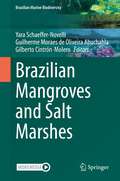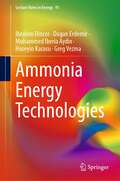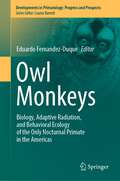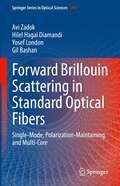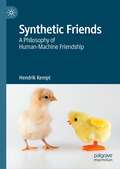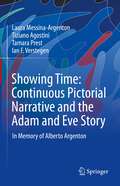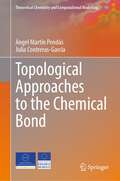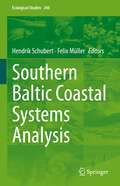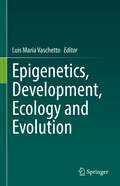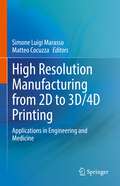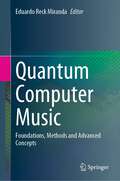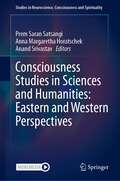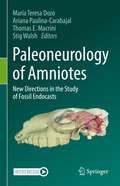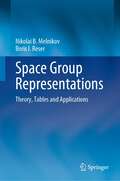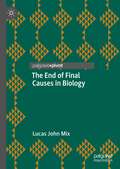- Table View
- List View
Closed Loop Control and Management: Introduction to Feedback Control Theory with Data Stream Managers
by Serge ZacherThe block diagrams as engineering means for closed loop control, which have been established by classic control theory for decades, are replaced in the above mentioned book by networks, the signals are replaced by data. It corresponds to the „Industry 4.0“ and to the structure of today’s automatic control systems. Thereby a classic closed loop is treated not isolated from other elements of nowadays automation like bus communication and process logical control, and is completed in proposed book with new control elements, so called data stream managers (DSM). The proposed book treats the control theory systematically like it is done in classical books considering the new concept of data management. The theory is accompanied in the book with examples, exercises with solutions and MATLAB®-simulations.
Brazilian Mangroves and Salt Marshes (Brazilian Marine Biodiversity)
by Yara Schaeffer-Novelli Guilherme Moraes de Oliveira Abuchahla Gilberto Cintrón-MoleroThis book offers a new ecosystemic approach to the understanding of mangrove and salt marsh ecosystems. Brazil has one of the largest areas of mangroves in the world, where salt marshes might or might not be associated. Different landscapes comprise the extensive coastline, where mangrove and salt marsh species’ composition is discussed through the analysis of physiography, zonation, and succession processes. Both salt marsh and mangrove plants and the associated macroalgae will be characterized in their ecophysiological and phenological aspects, as well as genetic and epigenetic diversity. The chapters on microbial diversity and litterfall expose the well-known importance of these ecosystems as highly productive carbon sinks and pumps. The associated fauna of invertebrates (benthic meio and macrofaunas, especially brachyuran crabs) and vertebrates (fishes, birds, and mammals) are presented in a special section. The conservational approach encompasses issues, such as historical ecology, economic valuation, protected areas, environmental education, climate changes, and adaptive management.
Ammonia Energy Technologies (Lecture Notes In Energy Ser. #91)
by Ibrahim Dincer Dogan Erdemir Muhammed Iberia Aydin Huseyin Karasu Greg VezinaTransforming Education for Sustainability: Discourses on Justice, Inclusion, and Authenticity (Environmental Discourses in Science Education #7)
by María S. Rivera Maulucci Stephanie Pfirman Hilary S. CallahanThis book investigates how educators and researchers in the sciences, social sciences, and the arts, connect concepts of sustainability to work in their fields of study and in the classrooms where they teach the next generation. Sustainability, with a focus on justice, authenticity and inclusivity, can be integrated into many different courses or disciplines even if it is beyond their historical focus. The narratives describe sustainability education in the classroom, the laboratory, and the field (broadly defined) and how the authors navigate the complexities of particular sustainability issues, such as climate change, water quality, soil health, biodiversity, resource use, and education in authentic ways that convey their complexity, the sociopolitical context, and their hopes for the future. The chapters explore how faculty engage students in learning about sustainability and the ways in which working at the edge of what we know about sustainability can be a significant source of engagement, motivation, and challenge. The authors discuss how they create learning experiences that foster democratic practices in which students are not just following protocols, but have a stake in creative decision-making, collecting and analysing data, and posing authentic questions. They also describe what happens when students are not just passively receiving information, but actively analysing, debating, dialoguing, arguing from evidence, and constructing nuanced understandings of complex socioscientific sustainability issues. The narratives include undergraduate student perspectives on what it means to engage in sustainability research and learning, how students navigate the complexities and contradictions inherent in sustainability issues, what makes for authentic, empowering learning experiences, and how students are encouraged to persevere in the field.This is an open access book.
Owl Monkeys: Biology, Adaptive Radiation, and Behavioral Ecology of the Only Nocturnal Primate in the Americas (Developments in Primatology: Progress and Prospects)
by Eduardo Fernandez-DuqueThis book integrates three decades of owl monkey research conducted since 1994 when the first and only book focused on the genus Aotus was published. Owl monkeys were one of the least understood primates then; knowledge from wild populations was only beginning to emerge and there had been some substantial research in colonies of captive individuals. The situation is very different today. Research on captive owl monkeys has continued to develop, with valuable contributions to the health and medical sciences. And there is now enough information on the behavior, ecology, conservation, and biogeography of the genus that merits a synthesis. The book synthesizes new field data on the biogeography, behavioral ecology, circadian biology, population biology and demography spanning their entire continental range from Panamá to Argentina. It includes theoretical perspectives drawn from evolutionary biology, biological anthropology, anatomy, morphology and physiology, genetics, endocrinology and conservation biology to examine a specic set of adaptations that have allowed owl monkeys to exploit the nocturnal niche while functioning in a pair-living sexually monogamous system with remarkable patterns of paternal care. The author, with 30 years of research experience with both captive and wild primates, has directed the longest project on any owl monkey species and has conducted extensive original research on their biology, adaptive radiation and behavioral ecology. His expertise and published record on both wild populations and laboratory colonies makes this book one of a kind; it presents information from both captive and wild primates and explores questions through the integration of both approaches. The volume offers some additional features that make it novel in its approach: (1) brings together a combination of senior researchers who during four decades have established captive owl monkeys as a system of study with a new generation of younger scientists who have, for the last 10-20 years, been spearheading their study in the wild, (2) presents the work of a remarkably diverse range of authors representing all countries where owl monkeys are present, as well as researchers from the U.S and Europe, and (3) offers “synthesis” chapters; in doing so, it will surely become a reference book for those specifically drawn to owl monkeys, as well as for those interested in the research topics that are covered.
Sustainable, Smart and Solidary Seoul: Transforming an Asian Megacity (Sustainable Development Goals Series)
by Tony Robinson Minsun JiThis book showcases how innovative state policy in Korea transformed Seoul from one of the world’s most impoverished, polluted, and congested cities into a global leader in green urban planning, smart city innovations, and social economy initiatives that have dramatically improved the local quality of life. Today, Seoul’s urban planning innovations are increasingly touted as replicable best practices for export to cities across the globe.This book describes how innovative state policy has made Seoul a world leader in sustainable, smart, and solidary urban initiatives. Beginning in the 1960s, Seoul led the fastest urbanization and modernization project in world history, becoming a colossal 26-million-person metropolitan region and one of the largest footprints of humanity on earth, transforming the nation from one of the world’s poorest to having the 10th largest GDP in 2020.Today, Seoul has become one of the most productive and innovative urban agglomerations on earth. Seoul’s residents enjoy the world’s highest penetration of high-speed internet, a model mass transit system, and advanced smart-city technologies. The vast city has become increasingly green and sustainable, while also recycling about 90% of all waste. Seoul has become a leader in social economy innovations like cooperative villages, mutual benefit societies, and social investment funds that advance equitable development goals amid a booming capitalist economy. To broaden our imagination of what good urbanism can achieve, this book reviews Seoul’s recent innovations in smart, sustainable, and solidary urbanism, including: green urban planning, sustainable development through recycling and reuse, well-managed mass transit, smart city design, and solidarity economy initiatives.
Forward Brillouin Scattering in Standard Optical Fibers: Single-Mode, Polarization-Maintaining, and Multi-Core (Springer Series in Optical Sciences #240)
by Avi Zadok Hilel Hagai Diamandi Yosef London Gil BashanThis book, the first dedicated to the topic, provides a comprehensive treatment of forward stimulated Brillouin scattering (SBS) in standard optical fibers. SBS interactions between guided light and sound waves have drawn much attention for over fifty years, and optical fibers provide an excellent playground for the study of Brillouin scattering as they support guided modes of both wave types and provide long interaction lengths. This book is dedicated to forward SBS processes that are driven by co-propagating optical fields. The physics of forward SBS is explained in detail, starting from the fundamentals of interactions between guided optical and acoustic waves, with emphasis given to the acoustic modes that are stimulated in the processes. The realization of forward SBS in standard single-mode, polarization-maintaining and multi-core fibers is then discussed in depth. Innovative potential applications in sensors, monitoring of coating layers, lasers, and radio-frequency oscillators are presented. This book introduces the subject to graduate students in optics and applied physics, and it will be of interest to scientists working in fiber-optics, nonlinear optics and opto-mechanics.Provides the first treatment of forward stimulated Brillouin scattering (SBS) in book form;Reflects the dramatic recent increase in interest in forward SBS processes , driven in part by the promise of new fiber sensing concepts;Delivers a solid and comprehensive grounding in the physics of forward SBS along with detailed experimental set-ups, measurement protocols, and applications.
Neuropathologie des Drogenmissbrauchs
by Andreas BüttnerDieses Buch bietet einen umfassenden Überblick über den aktuellen Wissensstand zu Neuropathologien infolge von Drogenmissbrauch. In den ersten Kapiteln erhält der Leser detaillierte Informationen über die neurobiologischen Grundlagen des Drogenmissbrauchs und die Ergebnisse von Neuroimaging-Studien bei Drogenabhängigen. Der Schwerpunkt des Werks liegt auf neuropathologischen Befunden bei Drogenabhängigen für die vorherrschenden Substanzen, zu denen Cannabis, Opiate, Kokain, Amphetamin, Methamphetamin und ein breites Spektrum von Designerdrogen gehören. Diese Befunde werden durch histologische Abbildungen untermauert und im Zusammenhang mit aktuellen wissenschaftlichen Veröffentlichungen diskutiert. Das Buch enthält auch ein Kapitel, das sich speziell an Kliniker richtet und die Auswirkungen auf die weitere Therapie aufzeigt. Eine unverzichtbare Lektüre für Neuropathologen, Neurologen, Neuroradiologen und Psychiater sowie für andere Angehörige der Gesundheitsberufe und Wissenschaftler, die sich für das Problem des Drogenmissbrauchs interessieren und engagieren.
Raimo Väyrynen: With a Foreword by Olli Rehn and a Preface by Allan Rosas (Pioneers in Arts, Humanities, Science, Engineering, Practice #28)
by Raimo VäyrynenThis book provides a broad overview of Professor Raimo Väyrynen’s academic work, his role in international research organizations, and his contributions to policy debates. It offers an interesting review of important political issues during the time span of half a century, from disarmament in Europe to the changing relationship between state sovereignty and transnational forces. Väyrynen has dealt with the changing agenda of peace and international relations, security and the arms race, and the world economy. This book provides comprehensive analyses of the regional and systemic structure of international relations, with the emphasis on conflicts and warfare between nations. It argues that while states, even smaller ones, still matter, transnational issues are increasingly important. Taking a historical perspective, the articles suggest that large-scale violence and arms races have been recurrent and cyclical phenomena in international relations. These events reflect the deep-seated inequalities in the political and economic systems which, moreover, vary considerably between regions. The publication is important reading for any researcher as well as students, policy-makers and the science-oriented public at large. • Traces the changing agenda of international relations from disarmament and the world economy to the changing relationship between state sovereignty and transnational forces. • Provides analyses of the regional and systemic structure in international relations, with the emphasis on conflicts and warfare. • Argues that large-scale violence and the arms race have been recurrent and cyclical phenomena in international relations. • Reviews important political issues from peace and conflict in Europe to the changing power relationship in the world.
Synthetic Friends: A Philosophy of Human-Machine Friendship
by Hendrik KemptThis book explores the notion of whether we can be friends with machines in a philosophically meaningful way. Depending on our concept of friendship, we may be inclined to answer differently. Since social technology has made new forms of friendships possible between people across the globe, the author argues that the philosophical concept of friendship, forged thousands of years ago, should be re-examined. The author proposes a new approach to the debate that reflects the unique relationship we can build with machines as our synthetic friends.
Showing Time: In Memory of Alberto Argenton
by Ian F. Verstegen Laura Messina-Argenton Tiziano Agostini Tamara PrestHow does a visual artist manage to narrate a story, which has a sequential and therefore temporal progression, using a static medium consisting solely of spatial sign elements and, what is more, in a single image? This is the question on which this work is based, posed by its designer, Alberto Argenton, to whose memory it is dedicated. The first explanation usually given by scholars in the field is that the artist solves the problem by depicting the same character in a number of scenes, thus giving indirect evidence of events taking place at different times. This book shows that artists, in addition to the repetition of characters, devise other spatial perceptual-representational strategies for organising the episodes that constitute a story and, therefore, showing time. Resorting to the psychology of art of a Gestalt matrix, the book offers ha formattato: Italiano (Italia) Codice campo modificato ha formattato: Italiano (Italia) ha formattato: Italiano (Italia) researchers, graduates, advanced undergraduates, and professionals a description of a large continuous pictorial narrative repertoire (1000 works) and an in-depth analysis of the perceptual-representational strategies employed by artists from the 6th to the 17th century in a group of 100 works narrating the story of Adam and Eve.
Topological Approaches to the Chemical Bond (Theoretical Chemistry and Computational Modelling)
by Ángel Martín Pendás Julia Contreras-GarcíaThis graduate textbook provides comprehensive information on topological analysis in real space of the electronic structure. Application of the topological tools is becoming routine for understanding the outcome of quantum chemical calculations. This title thoroughly reviews a selection of currently available topological tools, their use and spectrum of applications and provides graduate students and researchers with information not easily obtained from the available textbooks. The book is accompanied by worked examples, exercises and solutions and is a great tool for any quantum chemistry or computational chemistry course at the graduate and advanced undergraduate levels.
Southern Baltic Coastal Systems Analysis (Ecological Studies #246)
by Hendrik Schubert Felix MüllerThis book gives an overall analysis of the current knowledge status about structures, functions, utilization for German Baltic coast ecosystems. The main focus of this book is on the aquatic area, but land/sea interactions as well as river outfalls are included as well. Characteristic for this book is the inclusion of social science aspects. Approximately one third of its extent will be about the ecosystem services. In this segment the results of the last 6 years are presented in which a comprehensive quantification of the social relevance of ecosystems was carried out covering the entire area of the German Baltic Sea. This part builds directly on the results of scientific investigations and are in relation to social ideals. The assessment will not only be economically and ethically but also the mechanisms that are used for the valorisation of the ecosystem services will be evaluated. Both sub-areas, the classic natural science part as well as the part of social science aspects, deal with the changes caused by increasing anthropogenic influence and social (including demographic) changes. This will be among others in the sense of an exemplary historical outline. The final chapter of the synthesis therefore not only presents a summary of the level of knowledge gained and a deduction of the research needs. It further contains a presentation of the application aspects resulting from the analysis of the social relevance gained from basic scientific research.The book is aimed at scientists (and students) of natural, life and social sciences, analysing functioning and structures of coastal ecosystems with regard to sustainable use and nature protection, including aspects of coastal protection. Besides, it is thought to become a reference for all levels of decision makers and stakeholders in coastal and marine management of the Baltic and North Sea region, providing also a blueprint for system analysis respecting for societal as well as biological aspects world-wide.
Covariant Techniques in Quantum Field Theory (SpringerBriefs in Physics)
by Enrique Álvarez Jesús AneroThe purpose of this book is to illustrate some of the most important techniques which are helpful in combinatorial problems when computing quantum effects in covariant theories, like general relativity. In fact, most of the techniques find application also in broader contexts, such as low energy effective (chiral) Lagrangians or even in specific problems in condensed matter. Some of the topics covered are: the background field approach and the heat kernel ideas. The arguments are explained in some detail and the presentation is meant for young researchers and advanced students who are starting working in the field. As prerequisite the reader should have attended a course in quantum field theory including Feynman’s path integral. In the Appendix a nontrivial calculation of one-loop divergences in Einstein-Hilbert gravity is explained step-by-step.
Epigenetics, Development, Ecology and Evolution
by Luis María VaschettoEpigenetic modifications comprise heritable gene expression changes that occur without alteration of the DNA sequence and 'co-act' with genetic factors to shape development processes and evolutionary trajectories. Multicellular organisms receive different types of environmental stimuli/stresses that trigger epigenetic modifications during development. These environmentally driven mechanisms represent an underlying cause of phenotypic diversity, especially in metazoans. This book aims to present some of the latest epigenetic insights into the development of metazoans (including humans) as an intersection between their ecology and evolution.
High Resolution Manufacturing from 2D to 3D/4D Printing: Applications in Engineering and Medicine
by Simone Luigi Marasso Matteo CocuzzaThis book provides a comprehensive presentation of the most frequently used high resolution manufacturing techniques available, as well as the polymeric materials used for each of the techniques. Divided into two parts covering the technologies and materials used and the impact on different research fields and case studies, High Resolution Manufacturing from 2D to 3D/4D Printing: Applications in Engineering and Medicine addresses issues like throughput improvement by volumetric 3D printing and presenting novel applications and case studies. In addition, this book also covers the latest breakthrough developments and innovations to help readers understand the future applications of this technology across various disciplines, including biomedicine, electronics, energy, and photonics.
Recent Advances in Electrochemical Promotion of Catalysis (Modern Aspects of Electrochemistry #61)
by Philippe Vernoux Constantinos G. VayenasThis contributed volume provides a critical review of research in the field of Electrochemical Promotion of Catalysis (EPOC). It presents recent developments during the past decade that have led to a better understanding of the field and towards applications of the EPOC concept. The chapters focus on the implementation of EPOC for developing sinter-resistant catalysts, catalysts for hydrogen production, ammonia production and carbon dioxide valorization. The book also highlights the developments towards electropromoted dispersed catalysts and for self-sustained electrochemical promotion which are currently expanding. This authoritative analysis of EPOC is useful for various scientific communities working at the interface of heterogeneous catalysis, solid state electrochemistry and materials science. It is of particular interest to groups whose research focuses on developments towards a better and more sustainable future.
Primary and Repeat Arterial Reconstructions
by Sachinder Singh Hans Mitchell R. Weaver Timothy J. NypaverThis text provides comprehensive atlas of open arterial reconstructions - primary and reoperations. This book describes in detail the 1) indications of the operation, 2) surgical anatomy 3) operative steps in a sequential order with easy to understand illustrations, 4) recognizing a potential complication 5) and if a complication occurs, the steps involved in managing the complication.
Quantum Computer Music: Foundations, Methods and Advanced Concepts
by Eduardo Reck MirandaThis book explores music with respect to quantum computing, a nascent technology that is advancing rapidly. There is a long history of research into using computers for music since the 1950s. Nowadays, computers are essential for the music economy. Therefore, it is very likely that quantum computers will impact the music industry in the time to come. Consequently, a new area of research and development is emerging: Quantum Computer Music. This unprecedented book presents the new field of Quantum Computer Music. It introduces the fundamentals of quantum computing for musicians and the latest developments by pioneering practitioners.
Consciousness Studies in Sciences and Humanities: Eastern and Western Perspectives (Studies in Neuroscience, Consciousness and Spirituality #8)
by Prem Saran Satsangi Anna Margaretha Horatschek Anand SrivastavThis book presents consciousness models from Eastern and Western perspectives that accommodate current scientific research in the natural sciences and humanities, from neurological experiments through philosophical enquiries to spiritual approaches. It offers up to date research from key disciplines in consciousness studies ranging from neurology, quantum mechanics, algorithmic science, mathematics, and astrophysics to literary studies, philosophy, and (comparative) theology. The volume examines the dichotomy between Western and Eastern perceptions of consciousness – where consciousness is perceived as brain activity by Western scientists, and as a divine presence by various religions, especially in the East. The essays contextualize each other and reciprocally illuminate the potential and limits of the respective approaches. The texts aim at a transdisciplinary and transcultural exchange of ideas in consciousness studies and address a readership from interested lay-readers to experts of the field. The volume is of interest to researchers of consciousness studies.
Exercise and the Brain: Why Physical Exercise is Essential to Peak Cognitive Health
by Robert W. BalohThis book focuses on the benefits of exercise for prevention and treatment of chronic brain disorders. It is a guide for finding the right exercise routine for each individual. The goal is to show the reader why everyone needs to exercise, especially as we get older. The brain needs physical exercise both for normal health and for preventing and treating diseases common with aging.How much exercise is needed? As we see throughout the book there is no one fits all rule with regard to the amount of exercise required. The key is to make exercise a part of one’s daily routine. The beneficial effect of exercise is transient, lasting days to weeks, so it must be a lifelong pursuit. Can we exercise too much? Anything done in excess can potentially be dangerous but with the common sense approach outlined in this book anyone, regardless of underlying health condition, can find some type of exercise that is safe and effective.
Paleoneurology of Amniotes: New Directions in the Study of Fossil Endocasts
by María Teresa Dozo Ariana Paulina-Carabajal Thomas E. Macrini Stig WalshThis book presents a detailed examination of the current state of knowledge in the field of paleoneurology in the main amniote groups (reptiles, birds and mammals), and advances resulting from new non-invasive technologies. The study of fossil endocasts is an area of considerable current interest, and has long been central to our understanding of the evolution of the brain, development of senses and behavioral adaptations in diverse vertebrate groups and across vertebrates as a whole. Recent advances in non-invasive imaging have significantly increased the number of fossil taxa for which brain morphology is known, and it may now be possible to quantitatively analyze the relative size of brain regions. Providing a general overview of current perspectives and problems in evolutionary neuroanatomy, this book is intended for a wide range of readers, including undergraduate and graduate students, teachers, and anyone with a special interest in paleoneurology. It is also useful as supplementary reading for courses in digital anatomy, vertebrate comparative anatomy, computed morphometrics, paleontology, neurology and radiology as well as evolution programs
Space Group Representations: Theory, Tables and Applications
by Nikolai B. Melnikov Boris I. ReserThis book is devoted to the construction of space group representations, their tabulation, and illustration of their use. Representation theory of space groups has a wide range of applications in modern physics and chemistry, including studies of electron and phonon spectra, structural and magnetic phase transitions, spectroscopy, neutron scattering, and superconductivity. The book presents a clear and practical method of deducing the matrices of all irreducible representations, including double-valued, and tabulates the matrices of irreducible projective representations for all 32 crystallographic point groups. One obtains the irreducible representations of all 230 space groups by multiplying the matrices presented in these compact and convenient to use tables by easily computed factors. A number of applications to the electronic band structure calculations are illustrated through real-life examples of different crystal structures. The book's content is accessible to both graduate and advanced undergraduate students with elementary knowledge of group theory and is useful to a wide range of experimentalists and theorists in materials and solid-state physics.
Good Robot, Bad Robot: Dark and Creepy Sides of Robotics, Autonomous Vehicles, and AI (Social and Cultural Studies of Robots and AI)
by Jo Ann OravecThis book explores how robotics and artificial intelligence (AI) can enhance human lives but also have unsettling “dark sides.” It examines expanding forms of negativity and anxiety about robots, AI, and autonomous vehicles as our human environments are reengineered for intelligent military and security systems and for optimal workplace and domestic operations. It focuses on the impacts of initiatives to make robot interactions more humanlike and less creepy (as with domestic and sex robots). It analyzes the emerging resistances against these entities in the wake of omnipresent AI applications (such as “killer robots” and ubiquitous surveillance). It unpacks efforts by developers to have ethical and social influences on robotics and AI, and confronts the AI hype that is designed to shield the entities from criticism. The book draws from science fiction, dramaturgical, ethical, and legal literatures as well as current research agendas of corporations. Engineers, implementers, and researchers have often encountered users' fears and aggressive actions against intelligent entities, especially in the wake of deaths of humans by robots and autonomous vehicles. The book is an invaluable resource for developers and researchers in the field, as well as curious readers who want to play proactive roles in shaping future technologies.
The End of Final Causes in Biology
by Lucas John MixThis book provides a straightforward introduction to teleology in biology, the work it did and the work it can do. Informed by history and philosophy, it focuses on scientific concerns. Seventeenth, eighteenth, and nineteenth century biologists proposed a menagerie of biological “actors” to explain power without appealing to Aristotelian vegetable souls and final causes. Three constraints on teleology narrowed the field, selecting among the various actors as they mutated and recombined. Methodological naturalism, local adaptation, and blind chance each represent a significant philosophical advance in biology. Kant, Darwin, and the Modern Synthesis provided a new teleology, grounded in natural selection, an etiological recursion of form and function, and the details of carbon chemistry on Earth. They naturalized teleology, but they also finalized nature, shifting conceptions about the world and science. Understanding these links – historical, philosophical, and theoretical – sets the stage for new work moving forward.

